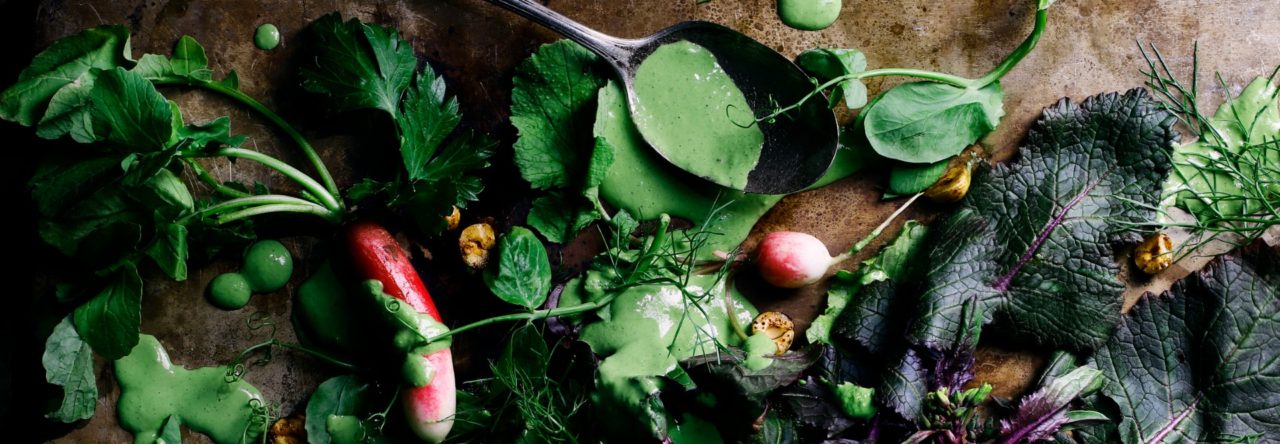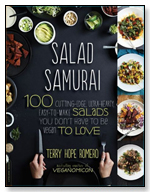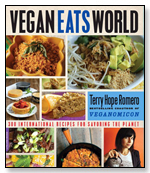It’s Sunday morning, I’m up far too early (jetlag has me running on London time) but if I accomplish one thing today it’s going to be catching the season 3 premier of Game of Thrones. And what better way to re-familiarize myself with my kitchen than crafting a vegan approximation of everybody’s favorite GoT food item (the book series is bursting with detailed descriptions of food and drink) the fascinating and gloriously gnarly medieval lamprey pie.
Sadly, lamprey eels, which look a little like nature’s cosplayers of that perfect X-Files episode, are endangered in the U.K., home to a long tradition of lamprey pie. Any renewed interest in the pie may not only be illegal depending where you live, but just bad news for the slippery little guys. Either way, I’m never going to eat a lamprey, but I love making pie. So an adventure in vegan eel pie is on the menu tonight.
Chewy, adaptable seitan, sliced into thin strips, is my stand in for these beloved parasitic bloodsuckers. Ancient recipes for the pie reveal the medieval chefs’ fondness for flavoring meaty foods with sugar, wine or ale and exotic spices such as cinnamon, cloves, nutmeg and occasionally mustard. Rather than throw sugar into this savory pie, I opted for pairing it with naturally sweet parsnips and a long sauté of the onions to unlock their sugars. I love cooking with booze so naturally I reached for the of ale (a domestic IPA) and a touch of nutmeg, cinnamon, and ground mustard creates an aromatic, hearty pie worth getting in trouble in a castle dungeon for (something I recall reading in one of the books, maybe? It’s been a while).
Round out this meal with a shot of green: toss together fresh spinach with toasted hazelnuts, fig balsamic vinegar, a dash of olive oil, Maldon salt, and a twist of black pepper. I recall characters in the book dining on something salad-like at lavish dinners, along with olives and a certain “Dornish chickpea paste” that sounds too similar to hummus, proof that the world of Game of Thrones is totally vegan friendly.
For the crust I use my go-to favorite, the rich and flakey Olive Oil Double Crust in Vegan Pie in The Sky, made with 1 part all purpose flour and 1 part white whole wheat flour. Or use any double crust pie dough you like; a coconut oil crust would be especially decadent. I like to make potpies in a variety of different shaped oven proof dishes and bowls; the wavy edge square dish in the photos is just big enough for two, and the remaining pie stuff was baked in a deep 9 x 11 ceramic dish.
I have no idea if this tastes like genuine lamprey pie, or if these pies can rescue an endangered species (but if a few lamprey are left uneaten, it may help a bit). But when you play the game of (tasty vegan) pies, everybody wins!
Save the Lamprey Seitan & Ale Pie
Serves 4-6 made in a 10 inch round deep dish or 13 x 9 inch square plate
Crust tip: Make any pie crust recipe suitable for a 9 inch double crust, flatten the dough to about an inch thickness roughly the same shape of the baking dish(s) and sandwich between two large pieces of waxed paper. Use a rolling pin to roll the dough into a shape about 1 inch wider than the edges of the dish and chill while the filling is prepared. When ready to bake, rip off the top layer of paper and slap it directly on top of the filling in the dish. Gently shape the edges against the sides of the dish, pressing the dough to seal the edges. Use the tip of a knife to slice a few air vents through the top of the crust.
Seitan tip: If you’re making seitan, use any Veganomicon seitan recipe or the Red Seitan from Viva Vegan!. If using store-bought, slice up 2 eight-ounce packages.
Ingredients
- 1 recipe double pie crust, rolled and chilled as directed above
Filling:
- 16 ounces seitan (purchased or homemade) sliced into thin 1/4 inch slices.
- 3 cups thinly sliced yellow onions (sliced into half moons)
- 2 bay leaves
- 3 tablespoons olive oil
- 1 rib celery, finely chopped
- 1 large parsnip (about 1/2 pound) peeled and finely diced
- 2 tablespoons all purpose flour
- 1 1/2 cups light colored ale (about one 12 ounce bottle)
- 2 cups richly flavored vegetable broth (I used a concentrated batch of veg Better Than Bouillon)
- 1 tablespoon prepared Dijon mustard
- 1/4 teaspoon ground cinnamon
- 1/8 teaspoon ground nutmeg
- 1/2 teaspoon smoked salt (or kosher salt) or season to taste
- Freshly ground pepper to taste
- 3 tablespoons finely chopped chives
1. Preheat oven to 400 degrees. Have ready a deep dish 10 inch pie dish or 13 x 9 rectangle baking dish. Over medium high head preheat a 12 inch stainless steel pan. Add 1 tablespoon olive oil and sauté seitan until lightly browned, about 4 minutes. Transfer seitan to a bowl, add 1/2 cup of the ale to the pan and simmer and stir a few minutes to release any fried bits of seitan from the bottom and the ale is reduced by half. Pour the ale (now loaded with tasty bits of fried seitan) over the seitan in the bowl and set aside.
2. Heat the remaining oil in the pan, add the onions and saute for 8 minute or until very tender and golden brown. Add the bay leaves, celery, and parsnip and fry for 4 minutes. Sprinkle on the flour and stir for 2 minutes to coat everything in flour, then stir in the remaining 1 cup of ale. Stir and simmer for 2 minutes until thick and bubbling, then add the broth, mustard, cinnamon, nutmeg, and seitan. Stir occasionally and simmer for 6 to 8 minutes to thicken up a bit. Taste the gravy and add smoked salt and pepper as desired, then stir in the chives. Turn off the heat and discard the bay leaves.
3. Pour the filling into a baking dish(s) and cover with pie crust as directed in the tip above. Brush with a little plain almond milk and slide into the preheated over; slip a large baking sheet either underneath the pie or onto a baking rack directly beneath to catch any bubbling juices. Bake for 30 minutes; the pie is ready when the gravy is bubbling through the either the sides or the ventilation slits (told you it would bubble!). Remove and cool for 5 minutes before serving.



















